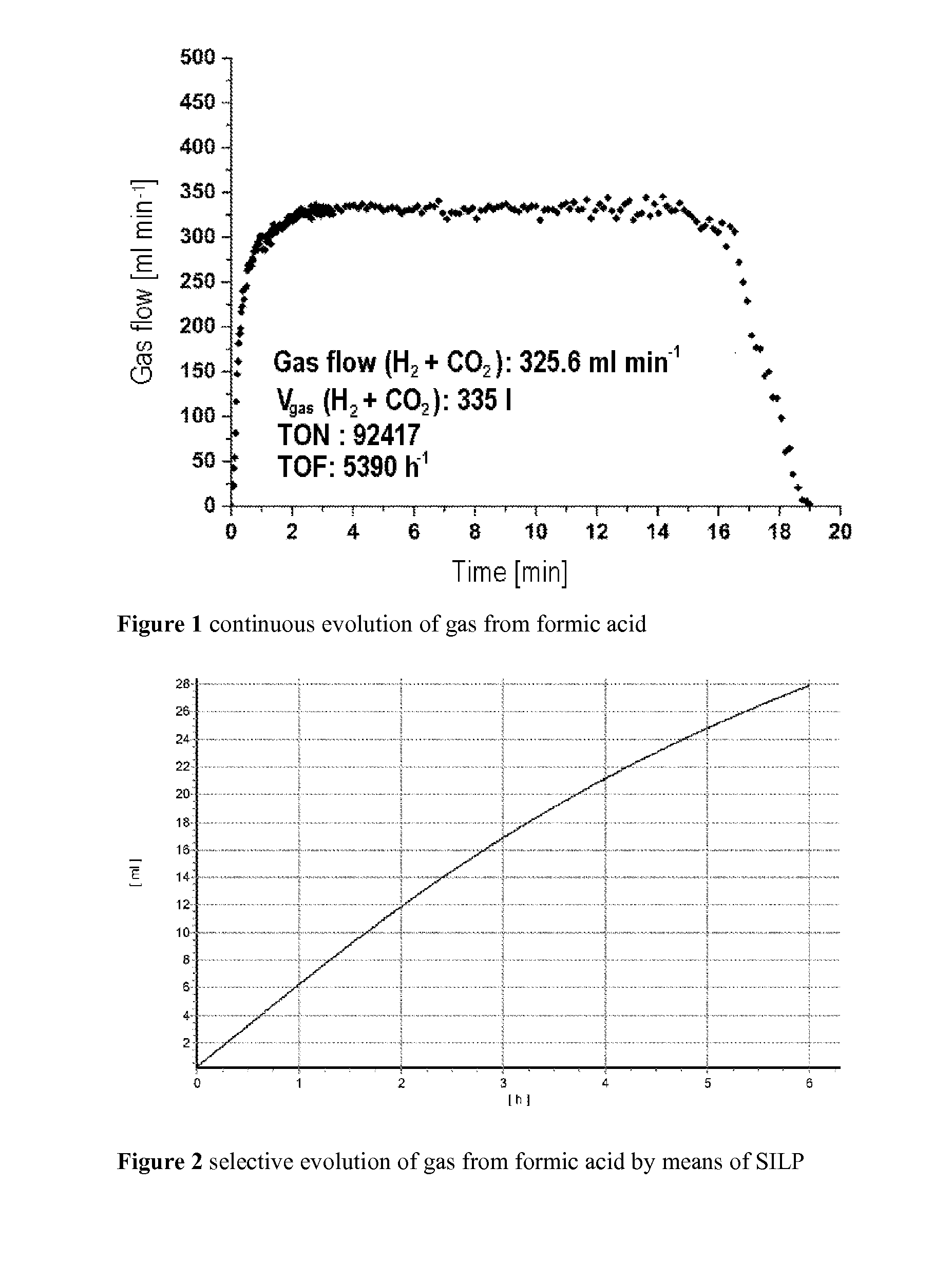Method for obtaining hydrogen by catalytic decomposition of formic acid
- Summary
- Abstract
- Description
- Claims
- Application Information
AI Technical Summary
Benefits of technology
Problems solved by technology
Method used
Image
Examples
example 1
Preparation of the ligands L1-L3
[0072]
DesignationFormulaL1L2L3
1a) Preparation of L1 (tris(2-(diphenylphosphino)phenyl)phosphine)
[0073]1.5 g (4.4 mmol) of (2-bromophenyl)diphenylphosphine are dissolved in 30 ml of absolute THF (tetrahydrofuran) under argon with magnetic stirring in a 100 ml three-neck flask provided with thermometer and reflux condenser. The mixture is cooled to −78° C. by means of a cold bath and, at this temperature, 3 ml of 1.6 N n-butyllithium in hexane (4.8 mmol) are added to the mixture by means of a dropping funnel over a period of 10 minutes. The mixture is stirred at this temperature for 30 minutes. 0.13 ml of phosphorus trichloride dissolved in 5 ml of absolute THF is subsequently added at this temperature over a period of 5 minutes. The reaction mixture is allowed to come to room temperature over a period of 1 hour while stirring, and is subsequently heated at reflux temperature (about 65° C.) for 1 hour. The solution is subsequently cooled and evaporated ...
example 2
Preparation of the Metal Complexes K1-K9
[0078]
DesignationGen. formulaK1[FeF(PP3)]BPh4K2[FeCl(PP3)]BPh4K3[FeBr(PP3)]BPh4K4[FeH(PP3)]BPh4K5[FeH(PP3)]BF4K6[FeH(H2)(PP3)]BPh4K7[Fe(acac)(PP3)]BPh4K8[Fe(ClO4)(PP3)]BPh4K9[FeF(L1)]BF4
Preparation of K1, [FeF(PP3)]BPh4
[0079]0.50 mmol of Fe(BF4)2*6H2O (169 mg) and 0.55 mmol of tris[(2-diphenylphosphino)ethyl]phosphane (369 mg) are firstly introduced in a countercurrent of argon into a Schlenk vessel (50 ml). 10 ml of distilled THF were subsequently introduced into the flask in a countercurrent of argon. The solution was stirred at room temperature for about 2 hours. 1.5 eq. (257 mg) of NaBPh4 were then added. The deep purple solution was subsequently evaporated to 5 ml under reduced pressure and admixed with 10 ml of distilled EtOH and stored overnight in a refrigerator (˜5° C.). The precipitated purple solid was then filtered off and washed with 4×2 ml of cold EtOH and 2×1 ml of n-hexane. The purple solid was subsequently dried at 10−3 mbar ...
example 3
Experimental Setup and Procedure for the Decomposition of Formic Acid
[0089]Description of the experimental setup for automatic determination of gas volumes: Boddien et al. GIT 2010, 8, 576.
PUM
 Login to View More
Login to View More Abstract
Description
Claims
Application Information
 Login to View More
Login to View More - R&D
- Intellectual Property
- Life Sciences
- Materials
- Tech Scout
- Unparalleled Data Quality
- Higher Quality Content
- 60% Fewer Hallucinations
Browse by: Latest US Patents, China's latest patents, Technical Efficacy Thesaurus, Application Domain, Technology Topic, Popular Technical Reports.
© 2025 PatSnap. All rights reserved.Legal|Privacy policy|Modern Slavery Act Transparency Statement|Sitemap|About US| Contact US: help@patsnap.com



